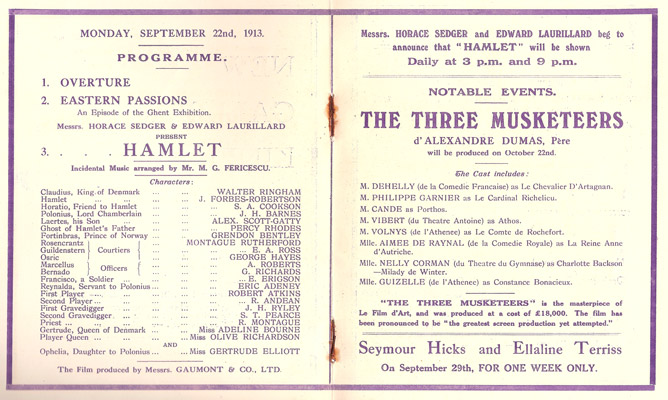The New Gallery Kinema opened at no. 121, Regent Street on 14 January 1913. The cinema got its name from a picture gallery that had been built on the site in 1888, but that had since been converted to a restaurant. The owners of the new venue, Edward Laurillard and Horace Sedger (directors of Electric Palaces, Ltd), spent a reported £80,000 on the project, making the New Gallery one of the most expensive cinemas to open in Britain before World War I.1 It was redeveloped extensively in the 1920s, and remained open as a cinema until the 1950s.2
At the outbreak of war in 1914, the New Gallery had already established itself as one of the West End’s main cinemas, and as a meeting place for London’s social elite. Its location on Regent Street, near some of the West End’s most fashionable shops and next-door to the restaurant Les Gobelins (which originally opened as the cinema’s in-house Brasserie), made it a logical port of call for well-to-do pleasure seekers in the capital.3 The cinema had also built up a reputation for showing ‘high-class’ pictures, including prestige productions of literary and dramatic works, such as feature-length adaptations of Les Miserables and Hamlet.
During World War I, the New Gallery’s prestigious reputation was used by various groups eager to harness the power of films for the war effort. Around London during the war years, many cinemas hosted patriotic screenings, sing-alongs and recruitment events. Proceedings at the New Gallery Kinema often combined patriotism with forms of international diplomacy. In 1916, the film distributor Mario Pettinati arranged a series of screenings at the New Gallery and other West End cinemas designed to galvanise support for Italy’s involvement in the war both among the Italian immigrant community in London and the British elite.4 At one of these events, in November 1916, the New Gallery celebrated the King of Italy’s birthday by showing official Italian war films to an audience that included the Italian Ambassador to Britain, Queen Alexandra and other members of the British royal family.5 Queen Alexandra lent her patronage to another event at the New Gallery the following year in aid of national ‘Navy Week’, where the highlight was the official British war film The Battle of Messines.6 She attended the cinema again in February 1918 to watch a series of films shown to raise money for her own Field Force Fund.7
The New Gallery’s patriotism could also be turned to commercial advantage once the war was over. In later years, its status as ‘the first Cinema to be honoured by the presence of H.M. Queen Alexandra’ was used to cement the venue’s image as ‘Society’s Picture House’, and ‘the only cinema in the West End with a tradition’.8
Image: Souvenir programme for a screening of Hamlet at the New Gallery Kinema, 22 September 1913.
Further reading:
- Pierluigi Ercole, ‘“Little Italy on the Brink”: The Italian Diaspora and the Distribution of War Films in London, 1914-18’, in Daniel Biltereyst, Richard Maltby and Philippe Meers (eds), Cinema, Audiences and Modernity: New Perspectives on European Cinema History (London: Routledge, 2012), pp. 154-65.
- Allen Eyles with Keith Skone, London’s West End Cinemas, third edition (Swindon: English Heritage, 2014).
- Chris O’Rourke, ‘“Afterwards to See a Cinema Show”: The Diary of a London Cinema-goer in 1915’, Early Popular Visual Culture, 13:1 (2015), 66-82.
- Jerry White, Zeppelin Nights: London in the First World War (London: Bodley Head, 2014).
- ‘From the Still to the Animated’, The Cinema, 8 January 1913, pp. 27-8. ↩
- ‘Opening of New Gallery Kinema’, The Cinema, 25 June 1925, Supplement, pp. 9-25; Allen Eyles with Keith Skone, London’s West End Cinemas, third edition (Swindon: English Heritage, 2014), pp. 71-4. ↩
- Souvenir opening programme, Bill Douglas Cinema Museum, University of Exeter, EXEBD 18898. See also Chris O’Rourke, ‘“Afterwards to See a Cinema Show”: The Diary of a London Cinema-goer in 1915’, Early Popular Visual Culture, 13:1 (2015), 66-82. ↩
- Pierluigi Ercole, ‘“Little Italy on the Brink”: The Italian Diaspora and the Distribution of War Films in London, 1914-18’, in Daniel Biltereyst, Richard Maltby and Philippe Meers (eds), Cinema, Audiences and Modernity: New Perspectives on European Cinema History (London: Routledge, 2012), pp. 154-65. ↩
- ‘Queen Alexandra at the New Gallery’, Kinematograph and Lantern Weekly, 16 November 1916, p. 6. ↩
- ‘Navy Week Films’, The Times, 26 July 1917, p. 3. ↩
- ‘Court Circular’, The Times, 12 February 1918, p. 9. ↩
- Souvenir opening programme, 12 June 1925, Bill Douglas Cinema Museum, University of Exeter, EXEBD 18900. ↩



